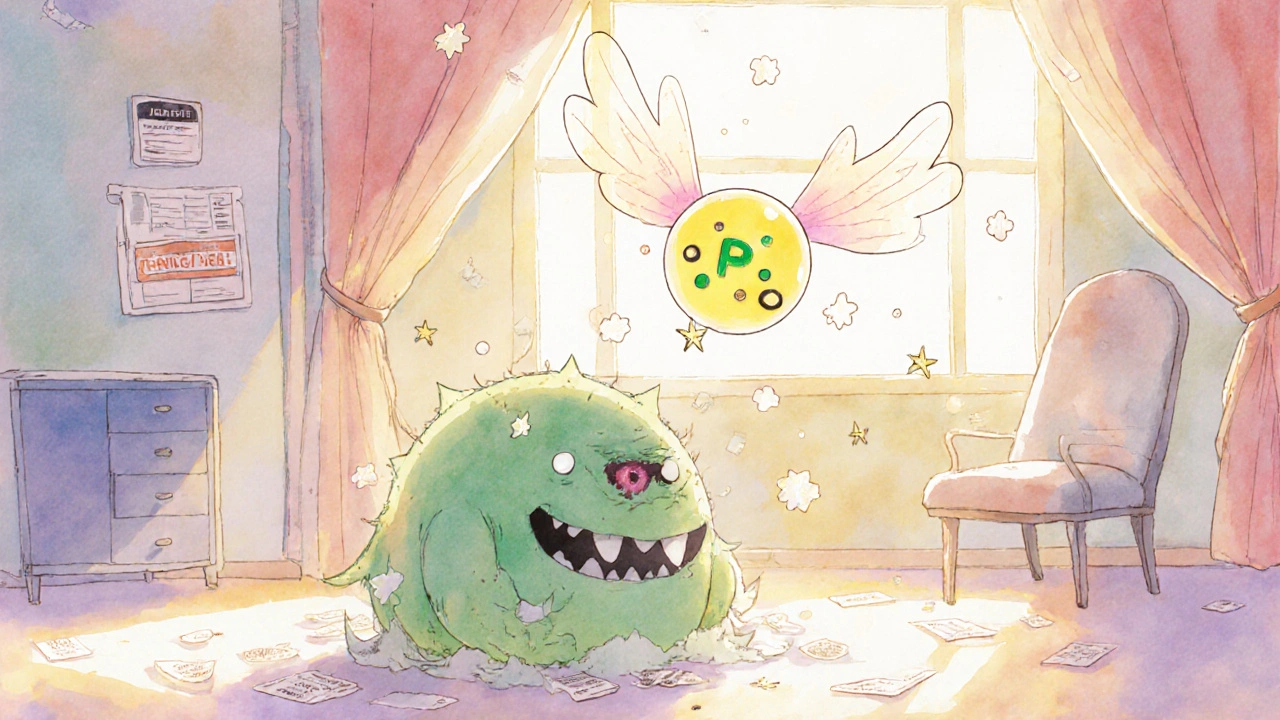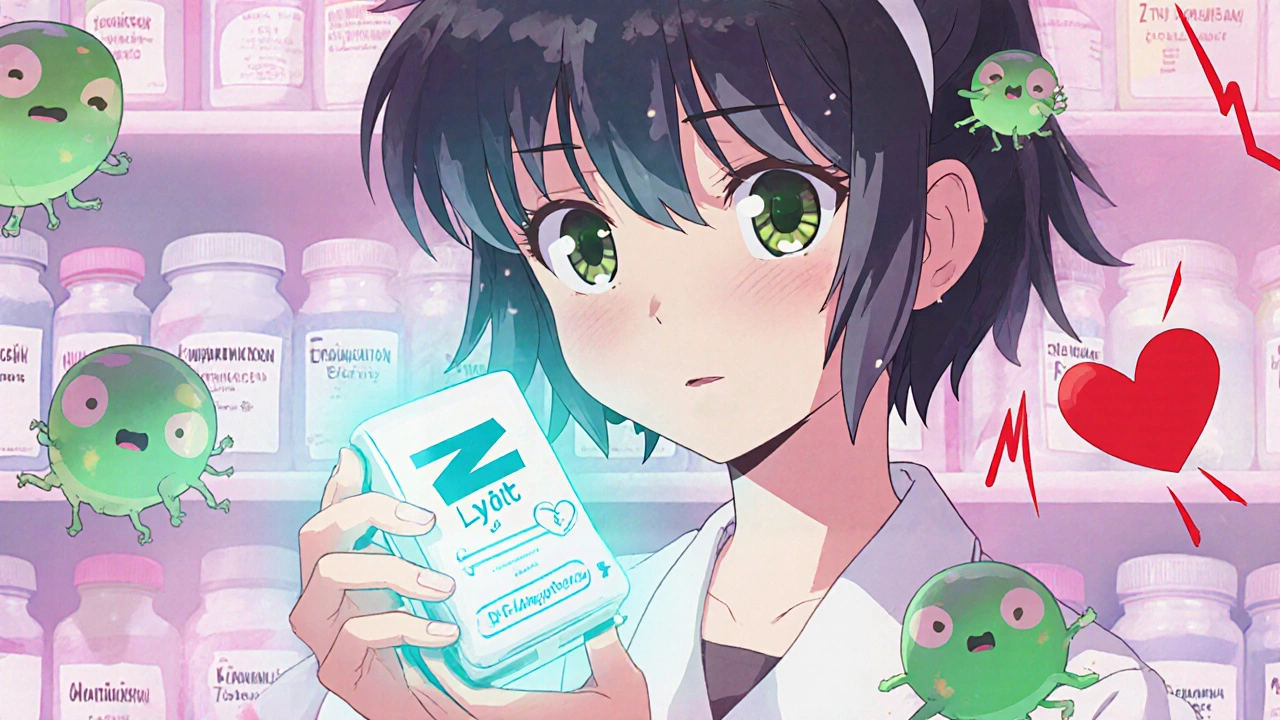
Antibiotics are one of the most important medical breakthroughs of the last century. Before they existed, a simple cut or sore throat could turn deadly. Today, they save millions of lives every year - but only if used correctly. Misuse is making them less effective, and side effects are more common than most people realize. If you’ve ever been prescribed an antibiotic, you need to know what you’re taking, why it’s being given, and what might happen next.
What Antibiotics Actually Do
Antibiotics don’t work on viruses. That means they won’t help with colds, flu, or most sore throats. They only fight bacterial infections - things like strep throat, urinary tract infections, pneumonia, and skin abscesses. They work in two main ways: some kill bacteria directly (bactericidal), others stop them from multiplying (bacteriostatic). The difference matters less in practice than you might think. What really counts is matching the right drug to the right bug.
The first antibiotic, penicillin, was found by accident in 1928 when Alexander Fleming noticed mold killing bacteria in a petri dish. By 1945, it was being mass-produced and used in World War II to treat wounded soldiers. Since then, antibiotics have cut death rates from bacterial pneumonia from 30% to under 5%. But we’re running out of options. The World Health Organization now calls antimicrobial resistance one of the top 10 global health threats, causing over 1.2 million deaths a year.
The Seven Main Classes of Antibiotics
There are dozens of antibiotics, but they fall into seven main groups. Each works differently and has its own risks and uses.
Penicillins: The Original
Penicillins are the oldest and still the most widely used. Amoxicillin alone accounts for nearly 120 million U.S. prescriptions each year. It’s often the first choice for ear infections, sinusitis, and bronchitis. Other types include ampicillin, penicillin V, and dicloxacillin for skin infections.
How they work: They break down the outer shell of bacteria, making them burst. Think of it like poking holes in a balloon.
Side effects: Nausea (15-20%), diarrhea (5-10%), stomach pain (10-15%), and yeast infections (2-8%) are common. Headaches happen in about 3-5% of people. About 10% of Americans say they’re allergic to penicillin - but studies show 90% of them aren’t. Many people outgrow it or were misdiagnosed. If you think you’re allergic, get tested before avoiding it forever.
Cephalosporins: The Penicillin Alternative
Cephalosporins like cephalexin and ceftriaxone are often used when someone says they’re allergic to penicillin. But cross-reactivity is rare - only 1-3% of penicillin-allergic patients react to cephalosporins. That means most people can safely take them.
They’re used for pneumonia, skin infections, urinary tract infections, and even gonorrhea. Cephalexin is the fourth most prescribed antibiotic in the U.S., making up nearly 5% of all antibiotic scripts.
Side effects: Diarrhea (5-15%), nausea (3-10%), and mild rash (1-3%). Severe reactions like Stevens-Johnson syndrome are extremely rare - fewer than 1 in 10,000.
Tetracyclines: For Acne and Lyme Disease
Doxycycline is the most common tetracycline. It’s used for acne, Lyme disease, tick-borne illnesses, and some respiratory infections. It’s also used to prevent malaria in travelers.
How they work: They stop bacteria from making proteins they need to survive.
Side effects: Sun sensitivity is the big one - up to 20% of users get bad sunburns even with minimal exposure. Always wear sunscreen and avoid tanning beds. Stomach upset affects 15-25%. And crucially: do not give tetracyclines to children under 8. They permanently stain developing teeth yellow or gray. This effect is irreversible.
Macrolides: Azithromycin and the Heart Risk
Azithromycin (Zithromax) is the third most prescribed antibiotic in the U.S. It’s often called the “Z-pack” because it’s usually taken over five days. It’s used for strep throat, pneumonia, and chlamydia.
How they work: Like tetracyclines, they block protein production in bacteria.
Side effects: Nausea, vomiting, and diarrhea affect 10-20%. But there’s a hidden risk: QT prolongation. This is a heart rhythm change that can lead to dangerous arrhythmias. A 2022 study of 1 million patients found azithromycin increased cardiac risk by 2.15 times. People with existing heart conditions or those taking other heart medications should be cautious. Hearing loss is rare - only 0.5-1% - but it’s been reported, especially with high doses.
Fluoroquinolones: Powerful But Dangerous
Ciprofloxacin and levofloxacin are strong, broad-spectrum antibiotics. They’re used for serious infections like kidney infections, anthrax, and certain types of pneumonia.
How they work: They cut up bacterial DNA, preventing reproduction.
Side effects: The FDA issued a black box warning in 2016 because of irreversible damage. Tendon rupture - especially in the Achilles - happens in 0.1-0.4% of users. Peripheral neuropathy (nerve damage causing numbness or tingling) affects 0.2-0.5%. A 2023 study found a 2.7-fold higher risk of aortic aneurysm. These risks are low, but they’re real. For most common infections, fluoroquinolones should be avoided unless nothing else works.
Sulfonamides: The Old Guard
Trimethoprim-sulfamethoxazole (Bactrim, Septra) is the main one. It’s used for urinary tract infections and to prevent pneumonia in people with weakened immune systems, like those with HIV.
How they work: They block folic acid, which bacteria need to grow.
Side effects: Nausea and rash are common. But the big danger is severe skin reactions - Stevens-Johnson syndrome and toxic epidermal necrolysis. These are life-threatening. The risk is low - 1-6 cases per million - but they happen. If you get a fever, blistering skin, or mouth sores after starting this drug, stop it and get help immediately.
Glycopeptides: Last Resort
Vancomycin is the go-to for MRSA - a dangerous, drug-resistant staph infection. It’s given intravenously in hospitals. It’s on the WHO’s “RESERVE” list - meaning it’s only for when everything else fails.
How they work: Like penicillins, they attack the bacterial cell wall, but they bind to a different part.
Side effects: “Red man syndrome” - a flushing, itching rash - happens in 5-15% of people if it’s infused too fast. Slowing the drip fixes it. Kidney damage (nephrotoxicity) occurs in 5-30% of long-term users. Hearing loss (ototoxicity) affects 1-5%. Monitoring blood levels helps reduce these risks.

Why Antibiotic Resistance Is Getting Worse
Every time you take an antibiotic, you’re helping bacteria evolve. If you don’t finish the course, the strongest bugs survive. If you take them for a virus, you’re just exposing your body to side effects for no reason.
Here’s the scary part: MRSA resistance to vancomycin rose from 0.3% in 2010 to 1.2% in 2022. That might sound small, but it’s a trend. And only two new antibiotic classes have been developed since 2000. Pharma companies aren’t investing much - it’s expensive, and antibiotics aren’t as profitable as drugs for chronic conditions.
Doctors are trying to fix this. Antibiotic stewardship programs are now in 85% of U.S. hospitals. These programs make sure antibiotics are used only when needed and in the right dose. The result? A 35% drop in inappropriate use since 2017.
What You Can Do
You’re not powerless. Here’s how to protect yourself and help stop resistance:
- Don’t demand antibiotics for colds or flu. Ask if it’s bacterial first.
- Take the full course - even if you feel better. Stopping early is a major cause of resistance.
- Never share antibiotics. What works for one person might be dangerous for another.
- Report side effects. If you get diarrhea, rash, or joint pain, tell your doctor. These reports help track safety.
- If you think you’re allergic to penicillin, get tested. You might be able to use a safer, cheaper drug.
Also, pay attention to dosing. A 2023 study found 30% of outpatient antibiotic prescriptions had errors - wrong dose, wrong frequency. Always double-check the label. If it says “take twice daily,” don’t take it three times because you think it’ll work faster.

When to Worry About Side Effects
Most side effects are mild and go away. But some need immediate attention:
- Severe diarrhea with blood or mucus - could be C. diff infection.
- Rash with blistering or peeling skin - possible Stevens-Johnson syndrome.
- Sudden joint pain or tendon snapping - possible tendon rupture.
- Heart palpitations or dizziness - could be QT prolongation.
- Fever, chills, or swelling after starting an antibiotic - possible allergic reaction.
If you experience any of these, stop the medication and call your doctor or go to urgent care. Don’t wait.
Final Thoughts
Antibiotics are powerful tools - but they’re not harmless. They’ve saved countless lives, but their overuse is putting future generations at risk. The goal isn’t to avoid them entirely. It’s to use them wisely. When you need them, take them correctly. When you don’t, don’t take them at all.
The next time your doctor says you need an antibiotic, ask: What infection is this for? Is it definitely bacterial? Is there a safer option? That simple conversation could save you from side effects - and help keep antibiotics working for everyone.
Can I take antibiotics for a cold or flu?
No. Colds and flu are caused by viruses, and antibiotics only work against bacteria. Taking them for a viral infection won’t help you feel better faster - it just increases your risk of side effects like diarrhea or yeast infections, and contributes to antibiotic resistance. Save antibiotics for confirmed bacterial infections like strep throat, urinary tract infections, or pneumonia.
Is penicillin allergy real for most people?
Most people who think they’re allergic to penicillin aren’t. About 10% of Americans report a penicillin allergy, but studies show 90% of them can safely take it after proper testing. Many misremembered a childhood rash as an allergy, or had a viral rash while taking the drug. Getting tested with a skin test or graded challenge can confirm whether you’re truly allergic - and open up safer, cheaper treatment options.
Why do antibiotics cause diarrhea?
Antibiotics don’t just kill bad bacteria - they wipe out good bacteria in your gut too. This imbalance lets harmful organisms like C. difficile overgrow, leading to diarrhea. Mild cases clear up after stopping the antibiotic. Severe cases need specific treatment. Probiotics may help reduce risk, but they’re not a guarantee. If diarrhea is watery, bloody, or lasts more than 2 days, contact your doctor.
Can I drink alcohol while taking antibiotics?
For most antibiotics, moderate alcohol is safe. But with metronidazole, tinidazole, or some cephalosporins, alcohol can cause severe nausea, vomiting, and rapid heartbeat. With azithromycin or doxycycline, alcohol might worsen stomach upset or liver stress. It’s best to avoid alcohol while taking any antibiotic - your body is already working hard to fight infection. Plus, alcohol can weaken your immune system.
What happens if I skip a dose?
If you miss a dose, take it as soon as you remember - unless it’s almost time for the next one. Never double up. Skipping doses reduces effectiveness and increases the chance of resistant bacteria surviving. If you miss more than one dose, call your doctor. They may adjust your treatment. Consistency matters more than perfection - but don’t treat it like a suggestion.
Are natural remedies like honey or garlic as good as antibiotics?
Honey and garlic have mild antibacterial properties, but they’re not replacements for prescription antibiotics in serious infections. Honey can help soothe a sore throat or minor wounds, and garlic may support immune function. But for pneumonia, sepsis, or a kidney infection, relying on natural remedies alone can be life-threatening. Antibiotics are rigorously tested, dosed precisely, and proven to work. Don’t trade science for folklore when your health is on the line.
Koltin Hammer
November 17, 2025 AT 13:40Man, I remember when my grandma would say, 'If it ain't broke, don't fix it'-and then she'd pop a penicillin like it was candy for a sniffle. We’ve turned antibiotics into a magic bullet we toss at every sniffle and sore throat, and now the bugs are winning. It’s not just about personal health anymore; it’s evolutionary warfare, and we’re losing because we treat medicine like a vending machine. The fact that 90% of people who think they’re allergic to penicillin aren’t? That’s a system failure. We’re scared of side effects, but we’re not scared enough of what happens when we run out of options. The real tragedy isn’t the resistant superbugs-it’s that we still don’t treat antibiotics like the precious, fragile tools they are.
Phil Best
November 17, 2025 AT 23:19So let me get this straight-antibiotics are basically the opioid of the 21st century? We hand them out like free samples at a grocery store, then act shocked when people get addicted to them? 😏
Also, azithromycin giving you heart palpitations? That’s not a side effect-that’s a warning from your body saying, 'Bro, you’re not in a music video, stop taking Z-packs like they’re energy drinks.'
And don’t even get me started on the 'I’ll just skip a dose' crowd. You’re not being smart. You’re being a bacterial BFF.
Parv Trivedi
November 18, 2025 AT 04:24This article is very informative. I have seen many people in my country take antibiotics without prescription. They think it is a cure for everything. I hope more people read this and understand that antibiotics are not for colds or flu. We must respect science and use medicine wisely. Thank you for sharing this knowledge.
Willie Randle
November 18, 2025 AT 23:27Let’s be precise: the claim that '90% of people who think they’re allergic to penicillin aren’t' is backed by peer-reviewed studies from the CDC and the American Academy of Allergy, Asthma & Immunology. Misdiagnosis is rampant because of poor follow-up, self-reporting bias, and the fact that rashes during viral illnesses are often misattributed to the drug. A simple skin test or graded oral challenge can resolve this in under an hour. Yet, most primary care providers don’t refer patients for testing. That’s not just negligence-it’s a public health failure. We’re denying people access to safer, cheaper, more effective antibiotics because of misinformation. Fix this.
Connor Moizer
November 20, 2025 AT 23:12Look, I get it-you’re scared of side effects. But guess what? The side effects of NOT taking an antibiotic when you need it? Death. Pneumonia doesn’t care if you're 'natural.' C. diff is bad, but septic shock is worse. Stop being a scaredy-cat and start being responsible. If your doc prescribes it, take it. If you’re worried about resistance? Don’t take it for a cold. Simple. Stop overthinking. Stop Googling 'antibiotics and wine.' Just do what the science says. You’re not a biochemist. You’re a human who needs to stop treating medicine like a buffet.
kanishetti anusha
November 22, 2025 AT 02:15I’ve been taking doxycycline for acne for six months now, and I didn’t realize how much sun sensitivity it causes until I got a second-degree burn walking to my car. I thought I was just unlucky. Now I wear sunscreen like it’s armor. Also, I’ve started taking probiotics-just a daily one-and my stomach hasn’t been as upset. Not a cure, but it helps. I wish more doctors talked about this stuff before prescribing.
roy bradfield
November 23, 2025 AT 01:14They told us antibiotics were a miracle. But what if it was all a lie? What if the pharmaceutical companies knew about resistance decades ago and kept pushing them because they make more money selling new ones than they do curing diseases? Vancomycin on the WHO's 'RESERVE' list? That’s not a warning-it’s a confession. They’ve already sold us the cure, and now they’re selling us the problem. And who gets blamed? The patient who took a Z-pack for a sore throat. Meanwhile, the factory farms pumping antibiotics into livestock? Silent. The hospitals overprescribing? Silent. The real villains? The ones who profit. We’re not the problem-we’re the scapegoats.
Patrick Merk
November 24, 2025 AT 10:55I’m from Ireland, and we’ve got this weird thing where if you walk into a pharmacy and say 'I’ve got a cough,' they’ll hand you antibiotics like it’s a lollipop. It’s madness. My uncle took amoxicillin for a chest cold last winter and ended up in the hospital with C. diff. He’s fine now, but he’ll never take one again without a blood test. The real shame? The pharmacist knew it was probably viral. But they didn’t want to say no. That’s the system failing us-not the people. We need better education, not just more warnings.
Liam Dunne
November 25, 2025 AT 15:06Fluoroquinolones are the nuclear option of antibiotics. I’ve seen three patients in my clinic develop permanent nerve damage from them. One guy couldn’t feel his toes for two years. Another had tendon ruptures after hiking. These aren’t rare-they’re underreported. I stopped prescribing cipro for UTIs five years ago. Amoxicillin-clavulanate works just as well, and it doesn’t risk your Achilles. If you’re a young, healthy person with a simple infection? There’s almost always a safer option. Don’t let your doctor cut corners because it’s faster. Push back. Ask for alternatives.
Vera Wayne
November 27, 2025 AT 03:41I just want to say-thank you-for writing this with such clarity and care. I’ve been a nurse for 22 years, and I’ve watched families panic because they think antibiotics are the only way to get better. I’ve held hands during C. diff outbreaks. I’ve seen kids with antibiotic-resistant infections. This isn’t just science-it’s human stories. Please, if you read one thing today, read this: antibiotics are not a cure-all. They’re a last line of defense. Use them like you’re protecting the last fire in a snowstorm.
Rodney Keats
November 28, 2025 AT 03:08So let me get this straight: I can’t take antibiotics for a cold, but I can take them for a sinus infection that started as a cold? So the real problem isn’t the antibiotic-it’s the doctor who can’t tell the difference? Oh, and I’m supposed to trust a 10-minute office visit to diagnose a bacterial infection? Yeah, right. You’re not protecting us-you’re just making us feel guilty for being too lazy to die properly.